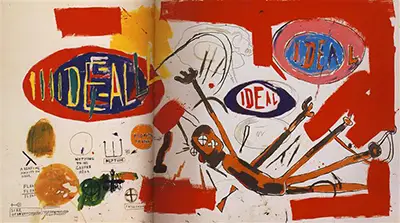The image seems to be a mixture of an aerial, map-like view of an area that may be entirely imaginary, and the depiction of the aftermath of a beating. The victim, seemingly prescient in the light of recent current events and worldwide global protests, is a black man, bearded, lying face down, his limbs flung out in shock, having been beaten. This is evident from the band-aids on the man's face, and the pool of blood in which he is lying. This is thought by critics to be symbolic of Basquiat's psyche in the months following the death of his friend and mentor, Andy Warhol. Unlike many of other Basquiat's works, there is no obvious antagonist depicted and the viewer is left to decide on the narrative behind the man's state. This is not to say that Basquiat left the viewer entirely on their own: the painting's map-like features come into play too.
Various colourful blobs ornament the left-hand side of the image, seeming to be tester spots where an impatient artist daubed the mixed colours to see their effect on canvas. But these spots are intentional, so much so that Basquiat left nothing open to interpretation here, labelling the splots with notations such as: 'A beating awaits you here', and 'nothing to be gained here' and even, chillingly, 'fatal injury'. As if these words were not enough, Basquiat has incorporated the symbols known as 'hobo-sign' that carry the same meanings as his words. These symbols were widely used by tramps and beggars to mark out properties that could be relied upon for a drink and a place to rest, warnings about those places too poor or mean to help others, and warnings to steer clear of those places where physical harm, verbal assault and possibly worse might await a chancing tramp. Floating like an orange sun in the middle-left of the painting, the words 'money orders' drift across the canvas, unexplained and vaguely menacing due to the perfectly circular red spot that mars the orange.
Above this less than idyllic scene, the word 'Ideal' is repeated three times, in varying sizes and in variegated colours. The layout of the 'Ideals' are such that they conjure up thoughts of advertising slogans, while the word itself can be seen as ironic: there is little ideal in this image of injury, threat and poverty; it could be a play on words for 'I deal' as in the commercialisation of Basquiat's art, or indeed the heroin habit that would cut short his vibrant life, or, again, it could refer to Basquiat's attempts to 'deal' with his grief over his friend's passing. Or it could be all three – it is, after all, art!


